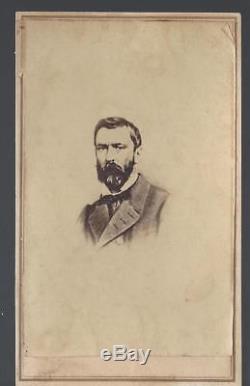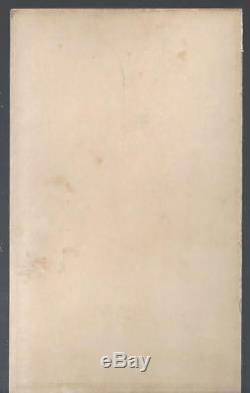Civil War CDV Confederate General Richard Taylor Fought in Louisiana



Richard Scott "Dick" Taylor (January 27, 1826 April 12, 1879) was an American planter, politician, military historian, and Confederate general. Following the outbreak of the American Civil War, Taylor joined the Confederate States Army, serving first as a brigade commander in Virginia, and later as an army commander in the Trans-Mississippi Theater. Taylor commanded the District of West Louisiana and was responsible for successfully opposing United States troops invading Louisiana during the Red River Campaign of 1864. He was the only son of Zachary Taylor, the 12th President of the United States. When the American Civil War erupted, Taylor was asked by Confederate General Braxton Bragg to assist him, as a civilian aide-de-camp without pay, at Pensacola, Florida. Bragg had known Taylor from before the war, and thought his knowledge of military history could help him to organize and train the Confederate forces. Taylor had been opposed to secession, but accepted the appointment. Manassas Junction, looking towards Bull Run and Centreville, Civil War-era drawing by Edwin Forbes. While training recruits, Taylor received news that he was commissioned as a colonel of the 9th Louisiana Infantry. The members of the 9th Louisiana voted for Taylor because they thought that with Taylor's connections to President Jefferson Davis, who was widower of his late sister Sarah, the unit would be sent out sooner and see battle more quickly. On July 20, he arrived in Richmond with his regiment and received orders from LeRoy Pope Walker, Confederate States Secretary of War, to board the train and move to Manassas to take part in the First Battle of Manassas; the 9th Louisiana arrived at Manassas Junction only hours after the battle was won by the Confederacy. On October 21, 1861, Taylor was promoted to brigadier general. Now he commanded a Louisiana brigade under Richard S. Ewell in the Shenandoah Valley campaign and during the Seven Days. When Taylor was promoted over three more senior regimental commanders, they complained of favoritism.
Davis wrote them a letter which noted Taylor's leadership capabilities and promise, and said that he had been recommended by General Stonewall Jackson. During the Valley Campaign, Jackson used Taylor's brigade as an elite strike force that set a rapid marching pace and dealt swift flanking attacks. At the Battle of Front Royal on May 23, the First Battle of Winchester on May 25, and finally at the climactic Battle of Port Republic on June 9, Taylor led the 9th Infantry in timely assaults against strong enemy positions.
Afterward, he traveled with the rest of Jackson's command to the Peninsula Campaign. His brigade consisted of various Louisiana regiments, as well as Major Chatham Roberdeau Wheat's "Louisiana Tiger" battalion. The undisciplined lot was known for its hard fighting on the battlefield, but also for its hard living outside. Taylor instilled discipline into the Tigers and, although Major Wheat did not agree with his methods, Taylor won his respect.
When Taylor was promoted to the rank of major general on July 28, 1862, he was the youngest major general in the Confederacy. He was ordered to Opelousas, Louisiana, to conscript and enroll troops in the District of Western Louisiana, part of the Trans-Mississippi Department. Winters wrote that Taylor was. To command all troops south of the Red River and was to prevent the enemy from using the rivers and bayous in the area.Troops were to be gathered and sent to fill up the ranks of Louisiana regiments serving in Virginia. After this, Taylor was to retain as many recruits as would be needed in the state. Light batteries of artillery were to be organized to harass passing enemy vessels on the streams.
The enemy was to be confined to as narrow an area as possible, and communications and transportation across the Mississippi River were to be kept open. After his service as a recruit officer, Taylor was given command of the tiny District of West Louisiana.
Governor Thomas Overton Moore had insistently requested a capable and dedicated officer to assemble the state's defenses and to help counter Federal forays into the state. Attacks of rheumatoid arthritis had left him crippled for days at a time and unable to command in battle. For instance, during the Seven Days battles, Taylor was unable to leave his camp and command his brigade. He missed the Battle of Gaines Mill, and Col. Isaac Seymour, commanding the brigade in his absence, was killed in action. During the spring of 1862, Union forces came upon Taylor's Fashion plantation and plundered it. Taylor found the district almost completely devoid of troops and supplies. However, he did the best with these limited resources by securing two capable subordinates, veteran infantry commander Jean-Jacques "Alfred" Mouton, and veteran cavalry commander Thomas Green. These two commanders would prove crucial to Taylor's upcoming campaigns in the state.During 1863, Taylor directed an effective series of clashes with Union forces over control of lower Louisiana, most notably at Battle of Fort Bisland and the Battle of Irish Bend. These clashes were fought against Union Maj. Banks for control of the Bayou Teche region in southern Louisiana and his ultimate objective of Port Hudson. After Banks had successfully pushed Taylor's Army of Western Louisiana aside, he continued on his way to Port Hudson via Alexandria, Louisiana. After these battles, Taylor formulated a plan to recapture Bayou Teche, along with the city of New Orleans, Louisiana, and to halt the Siege of Port Hudson.
In 1863, in response to Confederates summarily executing black U. Grant, wrote a letter to Taylor, urging the Confederates to treat captured black U. Soldiers humanely and professionally and not murder them.
Grant stated the official position of the U. Soldiers were sworn military men and not insurrectionist slaves, as the Confederates asserted they were. Operations to recapture New Orleans[edit]. Taylor's plan was to move down the Bayou Teche, overcoming the lightly defended outposts and supply depots, and then capturing New Orleans, which would cut off Nathaniel P.
Banks's army from their supplies. Although his plan met with approval from Secretary of War James A. Seddon and President Jefferson Davis, Taylor's immediate superior, Edmund Kirby Smith, felt that operations on the Louisiana banks of the Mississippi across from Vicksburg would be the best strategy to halt the Siege of Vicksburg. From Alexandria, Louisiana, Taylor marched his army up to Richmond, Louisiana.
There he was joined with Confederate Maj. Walker's Texas Division, who called themselves "Walker's Greyhounds".Taylor ordered Walker's division to attack Federal troops at two locations on the Louisiana side of the Mississippi. The ensuing Battle of Milliken's Bend and Battle of Young's Point failed to accomplish the Confederate objectives. After initial success at Milliken's Bend, that engagement ended in failure after Federal gunboats began shelling the Confederate positions.
Young's Point ended prematurely as well. After the battles, Taylor marched his army, minus Walker's division, down to the Bayou Teche region. From there Taylor captured Brashear City (Morgan City, Louisiana), which yielded tremendous amounts of supplies, materiel, and new weapons for his army. He moved within the outskirts of New Orleans, which was being held by a few green recruits under Brig.While Taylor was encamped on the outskirts and preparing for his attack against the city, he learned that Port Hudson had fallen. He withdrew his forces all the way up Bayou Teche to avoid the risk of being captured. In 1864, Taylor defeated Union General Nathaniel P. Banks in the Red River Campaign with a smaller force, commanding the Confederate forces in the Battle of Mansfield and the Battle of Pleasant Hill on April 8-9. He pursued Banks back to the Mississippi River and, for his efforts, received the thanks of the Confederate Congress.
At these two battles, the two commanders whom Taylor had come to rely on: Brigadier Generals Alfred Mouton and Thomas Green, were killed while leading their men into combat. On April 8, 1864, Taylor was promoted to lieutenant general, despite having asked to be relieved because of his distrust of his superior in the campaign, General Edmund Kirby Smith. The Congress of the Confederate States issued a joint resolution, which officially thanked Taylor and his soldiers for their military service during the Red River Campaign. Last days of the war[edit]. Taylor was given command of the Department of Alabama, Mississippi, and East Louisiana.
After John Bell Hood's disastrous campaign into Tennessee, Taylor was briefly given command of the Army of Tennessee, until most of its remnant was sent to contest Sherman's march through the Carolinas. [7] He surrendered his department at Citronelle, Alabama, the last major Confederate force remaining east of the Mississippi, to Union General Edward Canby on May 4, 1865, and was paroled three days later. [7] The rest of his company was paroled on May 12, 1865 in Gainesville, Alabama. The item "Civil War CDV Confederate General Richard Taylor Fought in Louisiana" is in sale since Tuesday, October 17, 2017. This item is in the category "Collectibles\Militaria\Civil War (1861-65)\Original Period Items\Photographs". The seller is "civil_war_photos" and is located in Midland, Michigan. This item can be shipped worldwide.
